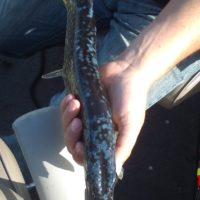Anyone on here ever seen anything like this? I certainly haven’t. Its just on the back of this small Pike, nowhere else. Parasites?
IDO » Forums » Fishing Forums » Fishing by Species » Muskie & Pike » What The…?
What The…?
-
May 16, 2018 at 8:50 am #1775016
That looks like blue spot disease (Esocid Herpesvirus1). I would send a note to the MN DNR and let them know when and where you caught it. They would probably appreciate knowing where this is taking place.
May 16, 2018 at 10:39 am #1775051Hmm, never heard of it. After a quick google search, its tough to tell. But I think I will send the DNR a E-mail and see what they say. I had another guy tell me its parasites that fall off the weeds onto these small Northerns that spend a lot of time in the weeds. What doesn’t make sense to me is why don’t the other fish that spend their whole lives in weeds get these markings?
 Tom SawvellInactivePosts: 9559May 16, 2018 at 12:50 pm #1775088
Tom SawvellInactivePosts: 9559May 16, 2018 at 12:50 pm #1775088Looks fungal to me. I’m with H4W on contacting the dnr regarding this.
May 16, 2018 at 1:54 pm #1775096I have an E-mail (w/pic) out to the DNR. I’ll report back with their conclusion when I get it back.
May 23, 2018 at 12:35 pm #1776469I have received back an e-mail:
Hi Nick
It sure is. (Blue Spot Disease) I observed this a lot in spring when I worked with spawning muskellunge in Wisconsin and see it each year in our area lakes in Minnesota when we handle northern pike in spring. I have attached an informative handout that Vermont uses, should answer your questions. Give me a shout if you have any additional questions.
Best regards.
<>< <>< <>< <º))))))))><
Thomas Burri
Assistant Area Fisheries Supervisor | Fisheries SectionMay 23, 2018 at 12:37 pm #1776471It seems to be fairly common & OK to the species. It was something I had never seen before.. Now I know!
 Rod Bent
Posts: 360
Rod Bent
Posts: 360
You must be logged in to reply to this topic.

